Differences in Presenting Concerns by Demographic and Identity Group
People are often curious about how the mental health concerns of students seeking treatment at college counseling centers differ by demographic and identity characteristics. In this blog, the Center for Collegiate Mental Health (CCMH) examines that question using data from the self-reported client demographics items in the Standardized Data Set (SDS) and the Clinician Index of Client Concerns (CLICC), a checklist of possible presenting problems that is completed by the clinician after evaluating a student who is seeking mental health services. When completing the CLICC, the clinician can check all relevant concerns from a list of more than 50 problem areas. There is often an assumption that certain demographic identity groups disproportionately experience higher rates of all mental health concerns across the board. In reality, the picture is much more nuanced. This blog examines the differences in rate of clinician assessed presenting concerns across the following demographic characteristics:
- Academic class status
- Race/Ethnicity
- Gender identity
- Sexual orientation
- International student status
- First generation
- Varsity athletics
- Disability status
- Military Service History
The tables presenting in this blog provide demographic breakdowns of the top concerns for over 78,000 students seeking treatment at 98 counseling centers in the 2018-2019 academic year. Each table presents the rate of clinician endorsement for the 10 most common concerns, as well as rates for selected less frequent concerns with interesting differences across that demographic breakdown. The top 10 concerns are separated from less frequent concerns in each table by a dashed line, and the number next to each concern indicates the overall rank for each of the 54 possible concerns. Full tables with rates of all concerns for each demographic group can be viewed here.
Academic Class Status
Students are asked to indicate their “Current academic status” by selecting one of the options listed below. Freshman/First-year and Graduate/Professional degree students had the highest rates of Adjustment to new environment as a concern. Senior and Graduate/Professional degree students had more Career related concerns. Graduate/Professional degree students had higher rates of Stress but lower rates of Depression compared to undergraduate students. Finally, rates of Suicidality and Social Anxiety decreased as academic class status increases.
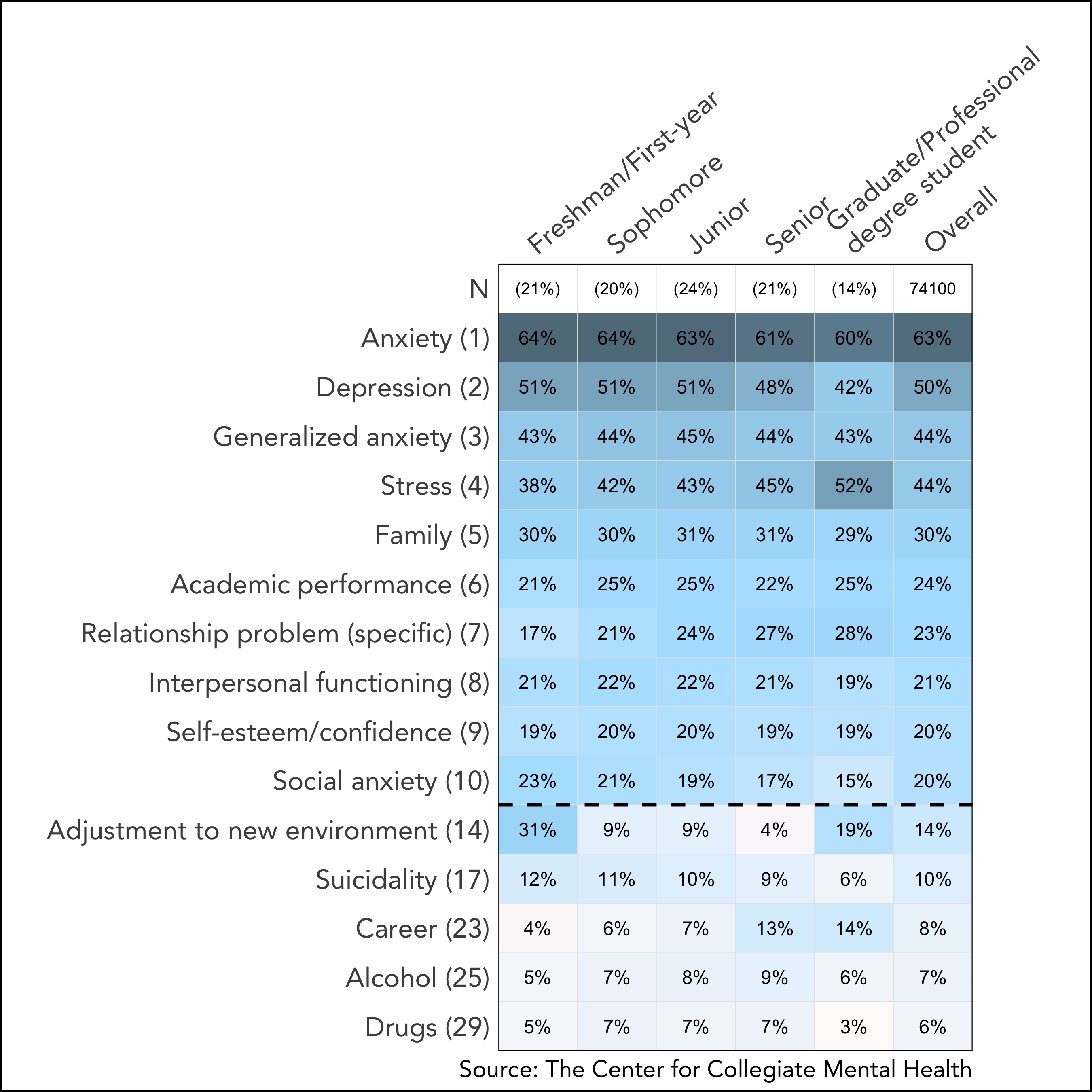
Race/Ethnicity
Students are asked “What is your race/ethnicity?” with the response options listed below. Anxiety and Depression are the most common concerns for all groups. Clients who identified as African American/Black had the lowest rates of Anxiety as a concern, while those identifying as Native Hawaiian or Pacific Islander had the highest rates of Depression. Clients identifying as African American/Black, Asian American/Asian, and clients who Self-identified their race/ethnicity had the highest rates of Racial, ethnic, or cultural concerns. Clients who Self-identified their race/ethnicity also had higher rates of Adjustment to new environment as a concern.
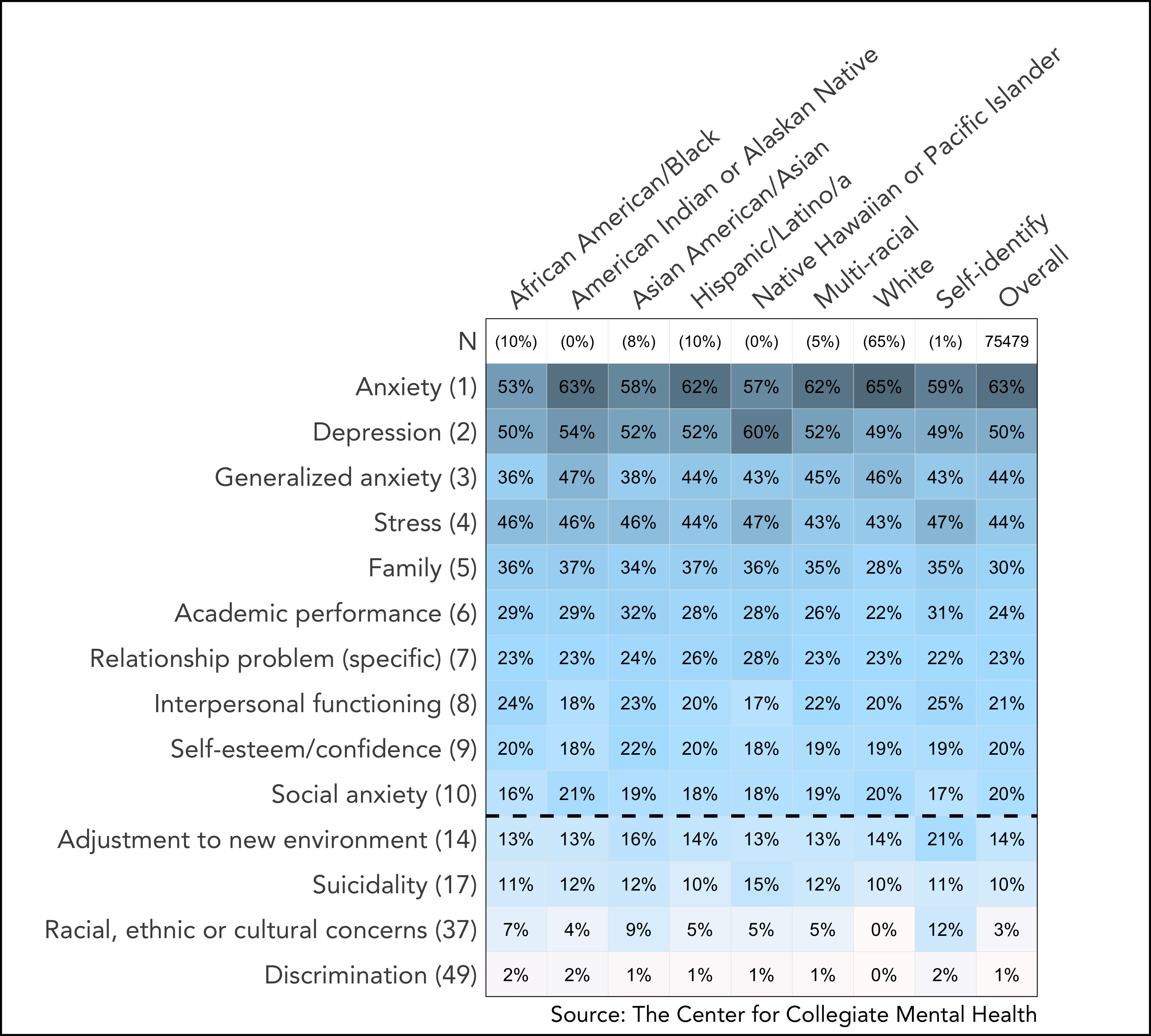
Gender Identity
Students are asked “Which of the following best describes your gender identity?” with the response options listed below (Note: Response options for this item were updated in 2020 after the data presented here to include Transgender woman, Transgender man, and Nonbinary). Over half of clients identifying as Transgender and a quarter of clients who chose to Self-identify were assessed by their therapist as seeking services due to Gender identity concerns. These groups also had higher rates of many other concerns compared to cisgender Female and Male clients (clients whose gender identity matches their sex assigned at birth): Family, Social Anxiety, Trauma, Suicidality, Identity development, Harassment/emotional abuse (victim), Self-injurious thoughts or behaviors and Sexual orientation. Clients who Self-identified also had the highest rates of Anxiety and Depression. Transgender clients and clients who Self-identified had lower rates of Specific relationship problems. Compared to Men, Women had higher rates of Trauma, Eating/body image, Sexual abuse/assault (victim), and Harassment/emotional abuse (victim). Notably, only 3% of Male clients presented with Sexual abuse/assault (victim) as a concern, while 13% of Female clients did. Men presented with higher rates of Alcohol and Drug related concerns.

Sexual Orientation
Students are asked “Which of the following best describes your sexual orientation?” with the response options listed below (Note: Response options for this item were updated in 2020 after the data presented here to include Asexual, Pansexual, and Queer). Compared to Heterosexual/Straight clients, those identifying as Bisexual, Gay, Lesbian, Questioning, and those who Self-identified have higher rates of Sexual orientation and Identity development as concerns, with Gay and Questioning clients having the highest rates of both presenting concerns. Additionally, clients identifying as Bisexual, Gay, Lesbian, Questioning, and those choosing to Self-identify have higher rates of Depression, Trauma, Suicidality, and Gender identity concerns compared to students who identify as Heterosexual/Straight.

International Student Status
Students are asked “Are you an international student?” with response options Yes or No. Client who identify as international students have lower rates of Anxiety as a concern, but higher rates of Stress. Additionally, clinicians assessed international students as experiencing higher rates of Adjustment to new environment, Social isolation, Career, and Racial, ethnic or cultural concerns.
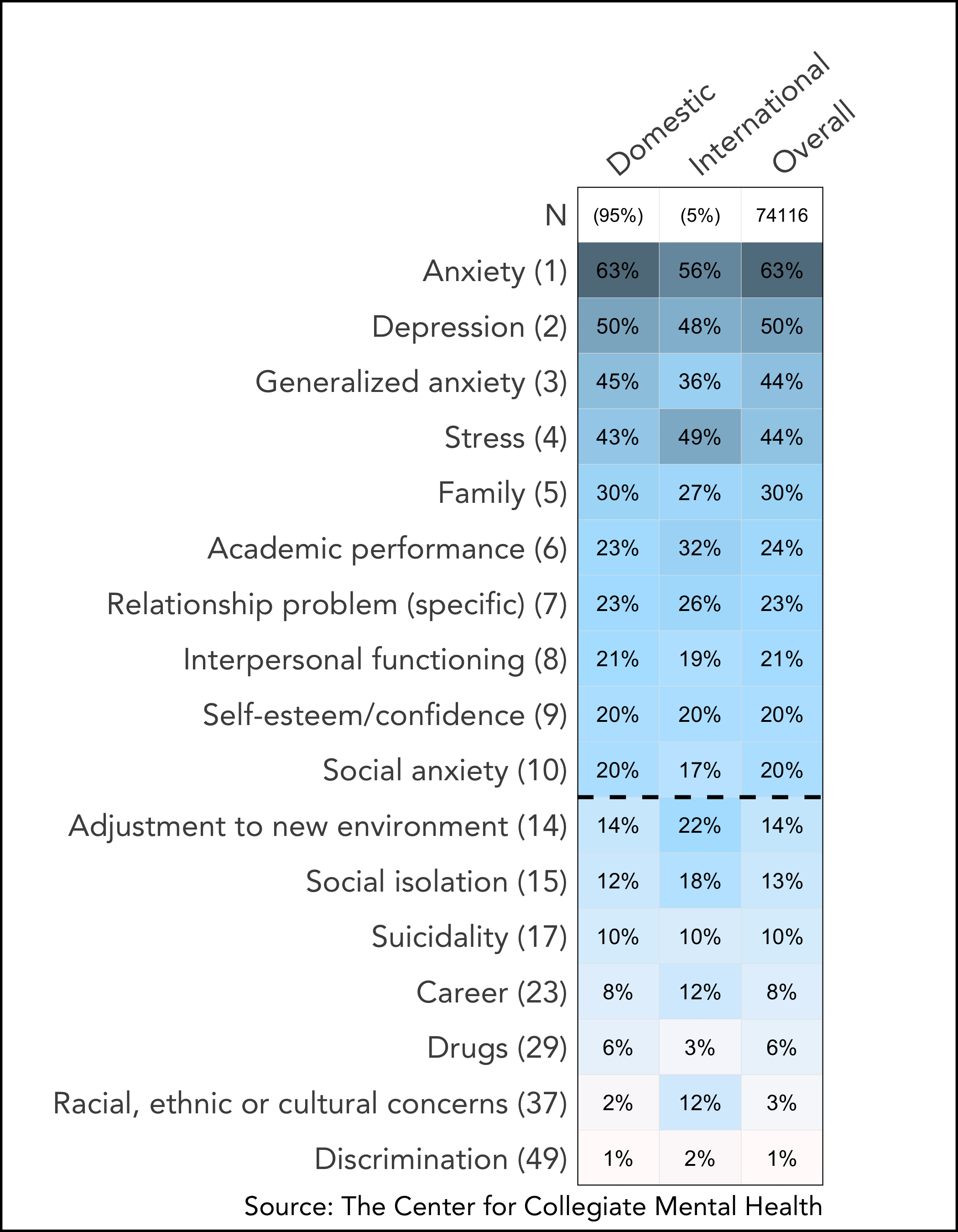
First Generation Student Status
Students are asked “Are you the first generation in your family to attend college?” with response options Yes or No. First generation students have higher rates of Family, Academic performance, Trauma, Financial, Physical abuse/assault (victim), and Racial, ethnic or cultural concerns compared to non-first generation clients.
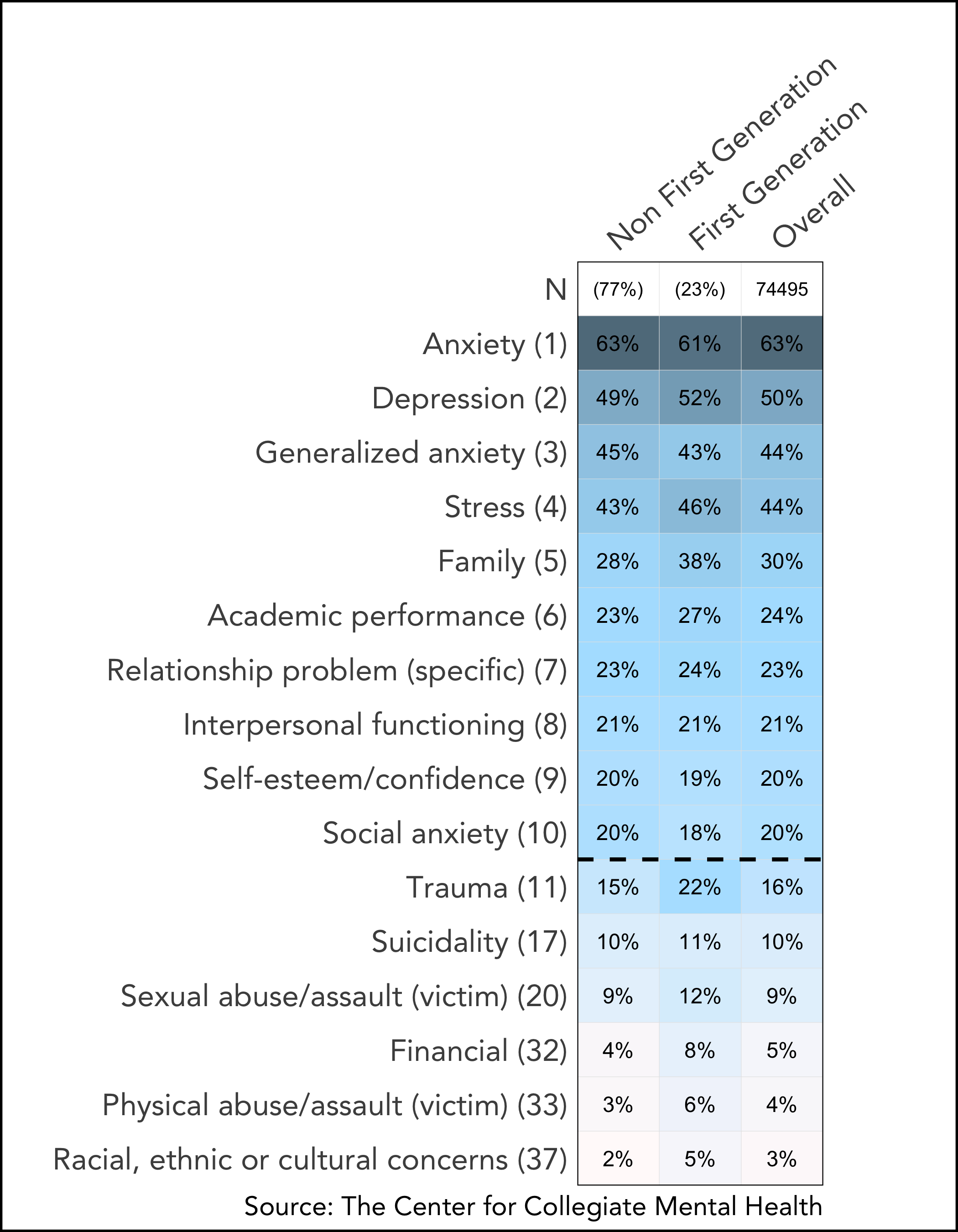
Varsity Athlete Status
Students are asked “Do you currently participate in any of the following organized college athletics? (Intramurals, Club, Varsity),” and then answer Yes or No to each form of participation. Varsity Athletes have lower rates of many common presenting concerns, including Anxiety, Depression, Family, Academic performance, Trauma, and Suicidality. They do, however, have higher rates of Stress, Perfectionism, Health/medical, and other concerns not included in the CLICC.
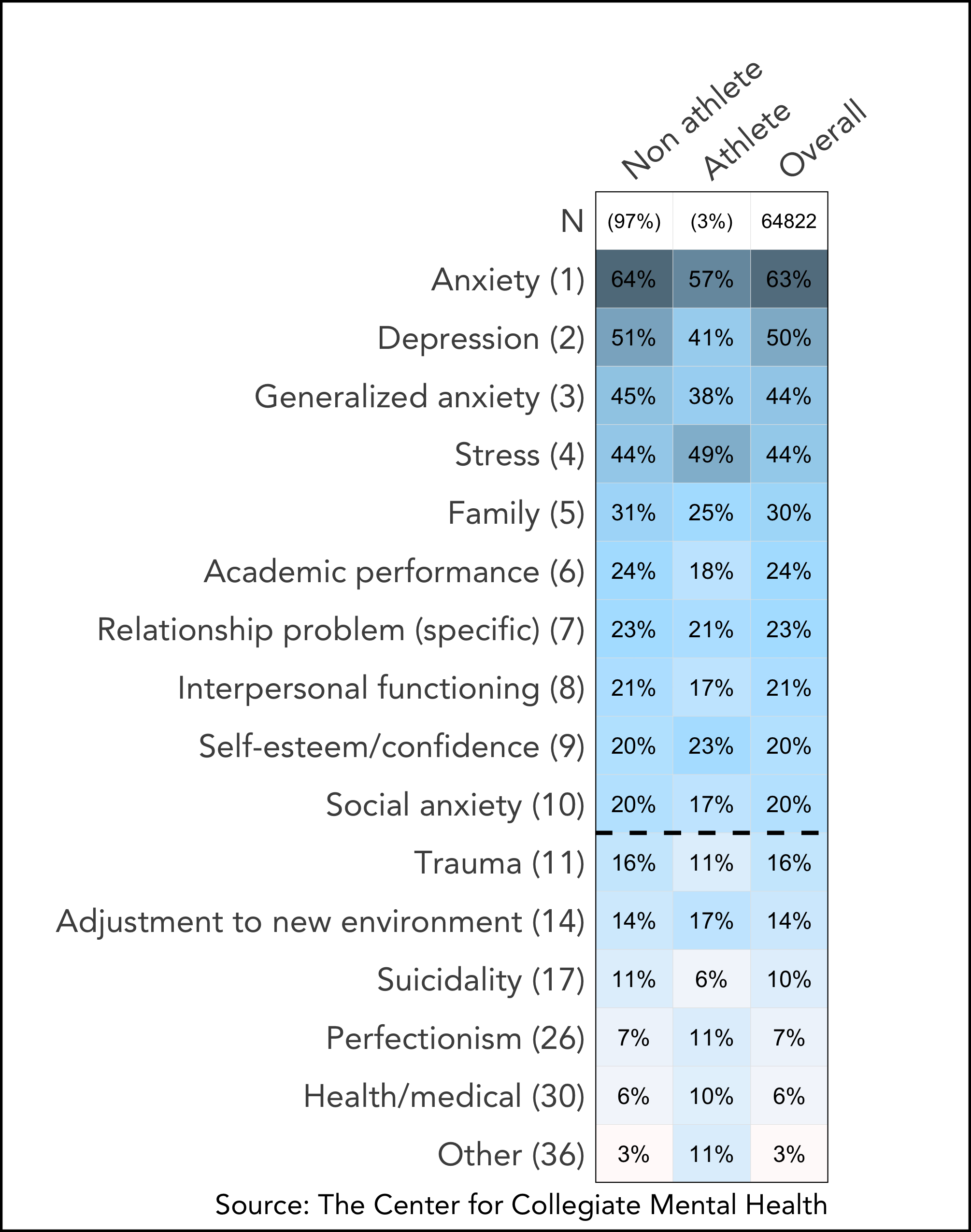
Disability Status
Students are asked “Are you registered, with the office for disability services on this campus, as having a documented and diagnosed disability?” with response options Yes or No. Most notably, clients with a registered disability have higher rates of Attention/concentration difficulties and health/medical concerns.
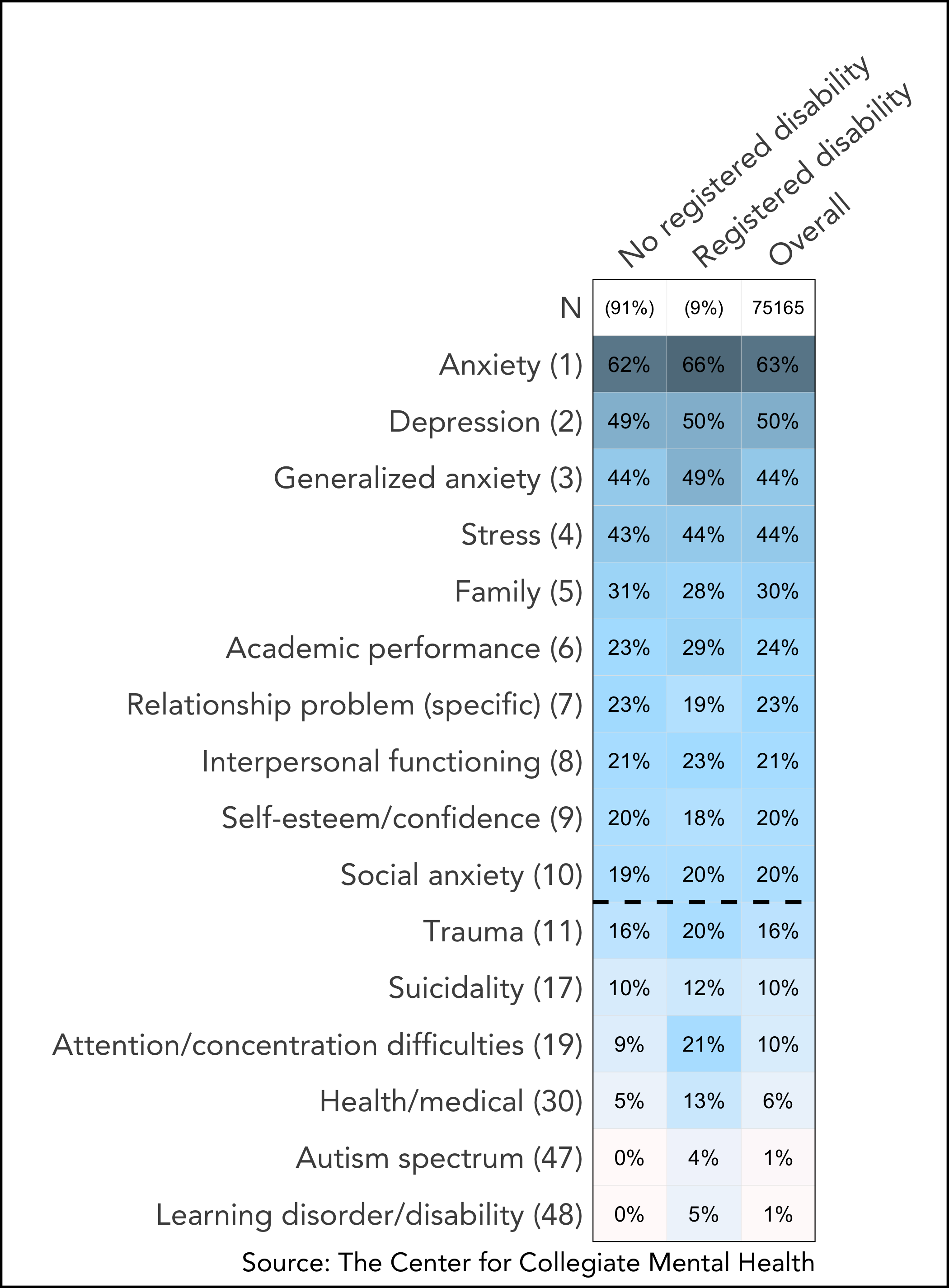
Military Service History
Students are asked “Have you ever served in any branch of the US military (active duty, veteran, National Guard or reserves)?” and then indicate Yes (Military Service) or No (No Military Service). Compared to clients who report no military service history, students with past military service have lower rates of Anxiety, relationship problem (specific), Self-esteem/confidence, Social Anxiety, and Perfectionism. Additionally, client with a military history were assessed by clinicians to have higher rates of Trauma, Alcohol, and Anger management concerns.
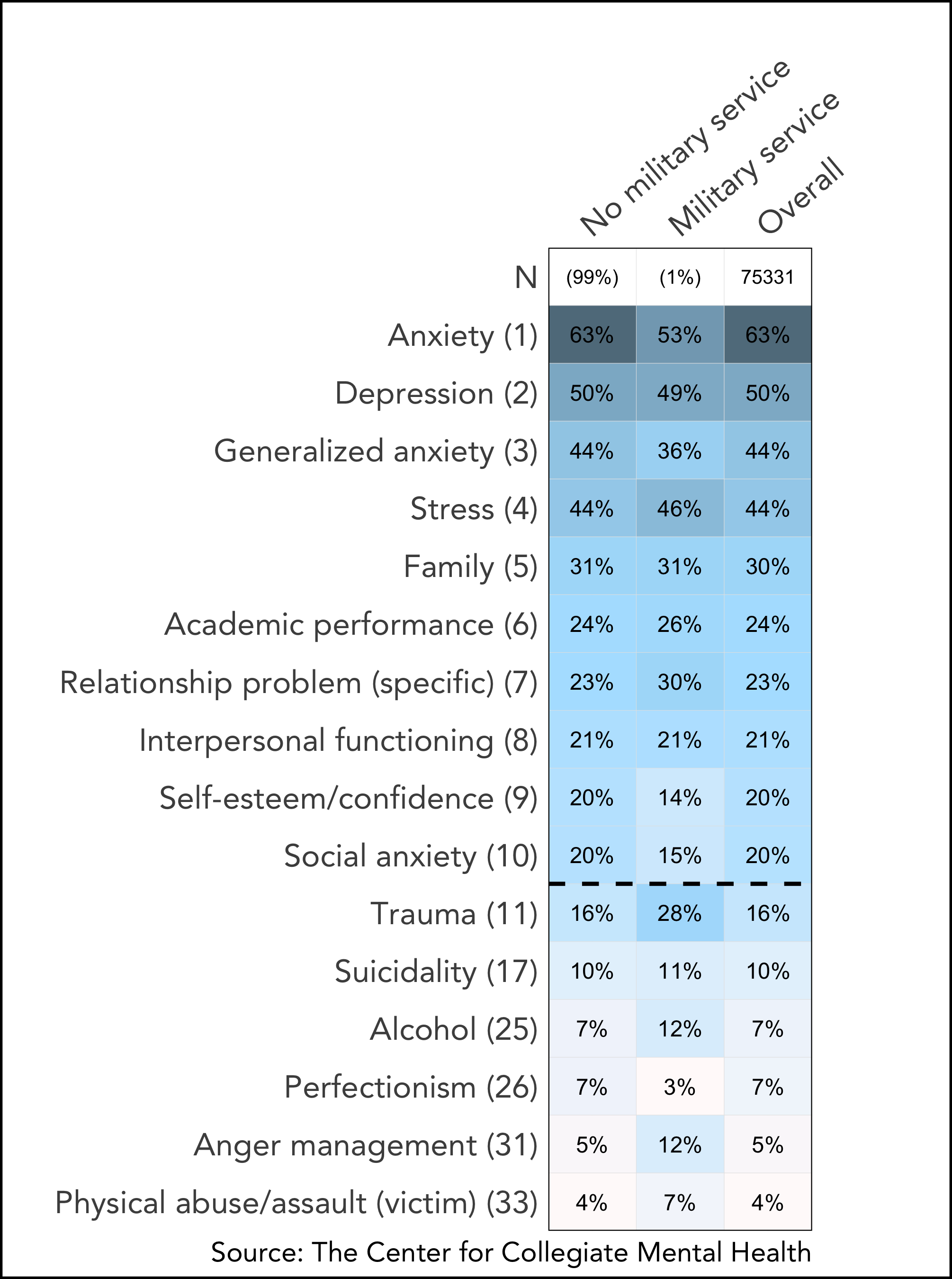
Summary and Considerations
In this blog, CCMH explored how client presenting concerns, as assessed by clinicians, differed across 9 different demographic variables. These results included data from over 78,000 students at 98 counseling centers during the 2018-2019 academic year. Results are too detailed and numerous to review individually but collectively they highlight the complexity with which presenting concerns vary across different demographic and identity groups. Readers are encouraged to closely examine the included tables that will inform your unique work with students.
Collectively, the results demonstrate that Anxiety and Depression were the most common concerns for all demographic and identity groups. Across the demographic variables examined, it is important to note that small and large differences were discovered in presenting concerns between the various identity groups. Additionally, there is considerable variability within each group, as no problem was endorsed for 100% of clients with a specific identity. Although the analyses highlight that no single demographic group is presenting for treatment with higher rates of all concerns across the board, the concerns that were relatively infrequent in the overall sample are often much higher in specific minority status groups (e.g. Gender identity concerns in clients identifying as Transgender or Self-identifying). The analyses from this blog in conjunction with the CCMH Blog evaluating negative COVID-19 impact by demographic group can provide invaluable information for colleges and universities to explore interventions that specifically attend to student-needs within each of the demographic groups evaluated. It is also important to highlight that some of the presenting concerns may be heightened for students with multiple intersecting identities. While further research will be needed to fully understand the nuanced relationship between presenting concerns and these demographic groups, colleges and universities are encouraged to consider how these results can be used to inform programming and support services at their campus.

